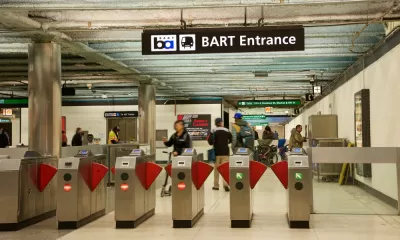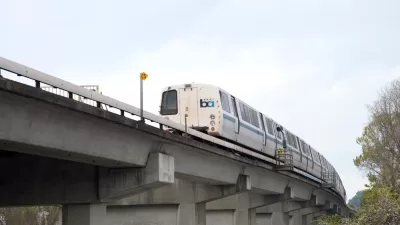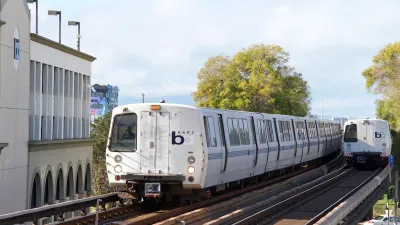Bay Area transit agencies employ rigorous protocols to ensure they’re prepared for the next major earthquake.

Californians know they should always be ready for the next earthquake—and that includes the state’s transit systems. In the San Francisco Bay Area, when the Loma Prieta earthquake struck in 1989, the Bay Area Rapid Transit (BART) system persisted with minimal disruptions. Ricardo Cano of the San Francisco Chronicle explains how the system prepares for major earthquakes.
“BART’s earthquake early warning detection system alerts the system to pending quakes and automatically signals trains to slow down at higher seismic intensities,” Cano writes. “Following an earthquake, [BART spokesperson James Allison] said, BART trains will stop (except for trains in the Transbay Tube and Berkeley hills tunnel) until it is determined it is safe to move the train to the nearest station, where riders will get off. Trains in the tube or tunnel move to the nearest station and then hold.” Staff are also trained and retrained regularly to respond to various levels of intensity.
San Francisco’s other major transit agency, Muni, and the ferry operator, San Francisco Bay Ferry, have similar processes in place. “Like BART, Muni personnel would assess damages and inspect the system’s infrastructure to determine how soon Muni service could continue. Motor buses would replace electric trolley buses and streetcars if an earthquake damaged the system’s power lines.”
FULL STORY: How the Bay Area’s transit services prepare for the next big earthquake

Alabama: Trump Terminates Settlements for Black Communities Harmed By Raw Sewage
Trump deemed the landmark civil rights agreement “illegal DEI and environmental justice policy.”

Study: Maui’s Plan to Convert Vacation Rentals to Long-Term Housing Could Cause Nearly $1 Billion Economic Loss
The plan would reduce visitor accommodation by 25% resulting in 1,900 jobs lost.

Why Should We Subsidize Public Transportation?
Many public transit agencies face financial stress due to rising costs, declining fare revenue, and declining subsidies. Transit advocates must provide a strong business case for increasing public transit funding.

Paris Bike Boom Leads to Steep Drop in Air Pollution
The French city’s air quality has improved dramatically in the past 20 years, coinciding with a growth in cycling.

Why Housing Costs More to Build in California Than in Texas
Hard costs like labor and materials combined with ‘soft’ costs such as permitting make building in the San Francisco Bay Area almost three times as costly as in Texas cities.

San Diego County Sees a Rise in Urban Coyotes
San Diego County experiences a rise in urban coyotes, as sightings become prevalent throughout its urban neighbourhoods and surrounding areas.
Urban Design for Planners 1: Software Tools
This six-course series explores essential urban design concepts using open source software and equips planners with the tools they need to participate fully in the urban design process.
Planning for Universal Design
Learn the tools for implementing Universal Design in planning regulations.
Smith Gee Studio
Alamo Area Metropolitan Planning Organization
City of Santa Clarita
Institute for Housing and Urban Development Studies (IHS)
City of Grandview
Harvard GSD Executive Education
Toledo-Lucas County Plan Commissions
Salt Lake City
NYU Wagner Graduate School of Public Service





























